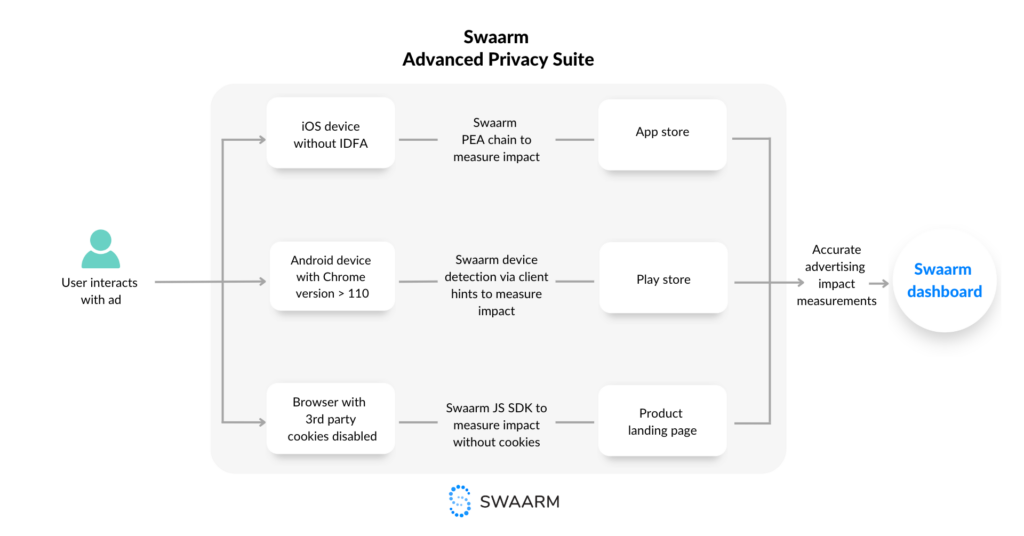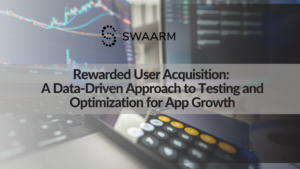In this article, originally published by VentureBeat, Alex Dumitru, CTO and co-founder of Swaarm talked about Advanced Privacy Suite for user acquisition, which prioritizes user privacy.
If you’ve watched mobile gaming in the past couple of years, you’ll have noticed that privacy and targeted advertising don’t go well together. But Swaarm is moving on to its second generation of user acquisition technology — the Swaarm Advanced Privacy Suite (APS) — with a focus on privacy.
Normally, the more you know about an individual, the better you can target ads at them. But Berlin-based Swaarm foresaw what would happen when Apple proposed privacy restrictions for third-party ads in mid-2020 and then implemented the change in the spring of 2021.
And so, it came up with privacy-enabled user acquisition technologies where advertisers can target groups of people, rather than individuals. That is one reason Swaarm, which was founded in October 2020 after the changes were announced, has been able to grow its business.
How it works
Swaarm’s APS solution ensures the user’s privacy is respected while ensuring campaigns are measured and monitored accurately. On both iOS, Android, and on the Web, the data that Swaarm tracks is always attributed to campaigns or traffic sources and not to individual user profiles.
APS uses no third-party cookies or device identifiers, ensuring that data collected by one advertiser can
never be correlated to data collected by other advertisers making user profiling impossible.
The technology behind it relies on assigning cohort tokens to large statistically significant user groups (think users with iOS devices in California) instead of assigning unique identifiers, which is impossible in platforms like iOS. The tokens are decoded after users perform certain events on advertiser platforms (e.g. subscribing, purchasing, etc.) and the data is attributed to the corresponding traffic segments of the campaign allowing it to be properly measured.
The privacy-enabled attribution tech helped those affected by Apple’s changes. But now an industry-wide solution is even more important as Google prepares to sunset third-party cookies and eventually change the privacy rules for the Android platform. As it did for iOS 14, Swaarm has developed a solution to help customers navigate the expected Google landscape, said Alexandru Dumitru, cofounder and CTO of Swaarm, in an interview with GamesBeat.
“Swaarm’s Advanced Privacy Suite is the first complete solution that helps advertisers and ad networks navigate the privacy minefield that we find ourselves in nowadays,” Dumitru said. “It’s the first solution that helps advertisers measure the performance of their marketing activities.”
The tech is targeted at advertisers (app developers, game developers, content websites), ad networks, and ad agencies.
APS users can easily measure their advertising performance metrics on every environment, be it iOS where opting-in for the Identifier for Advertising (IDFA) is an increasingly rare occurrence, Android where the user agent is being deprecated, or on the web where third-party cookies are being removed.
The company is working with a couple of beta customers to iron out any issues and it has had good results so far. Swaarm has 30 people.
The IDFA changes have affected a lot of companies, causing consolidation in the game industry as mobile game companies had worse results and needed to combine in order to become more stable and more easily navigate the privacy landscape. Zynga, for instance, acquired the hypercasual game maker Rollic to widen the funnel of users who come into its games and try to draw them into bigger mobile games.
Smaller companies couldn’t do this so easily.
“We’re trying to give the smaller and medium-sized players in the market tools to navigate this privacy change,” Dumitru said.
The privacy changes
Historically, tracking was never about invading the user’s privacy, but more about measuring the impact that ads have on a segment of users, Dumitru said. It was always important for advertisers or for ad networks to measure what impact they had, but no advertiser was concerned specifically with one user. They were concerned with cohorts of users trying to understand what they will buy or if they will subscribe to a certain service.”
Around 2008, with mobile advertising and social media, this changed as the big tech giants got involved.
“We had tracking being used for creating very detailed user profiles on every individual. And of course, this caused a lot of resentment from the general population.”
That concern is what Apple and Google reacted to, under pressure from government regulators.
Dumitru said the pendulum is now swinging from capturing individual user data to measuring the effectiveness of marketing activities, which can still be done without individual data. Instead, the data can be collected on groups of people with similar behavior. If you target these groups, you can still be successful, Dumitru said.
“If you are in a small player nowadays in the industry, it’s very difficult to navigate it,” Dumitru said. “If you’re a big enterprise, nothing changed as you have plenty of resources internally to deal with any change that might come from the politics or from big platforms.”
Key features
With Swaarm’s new tech, tracking and measurement are made possible in environments that are deprecating the user-agent browser feature. Full device information can still be gathered via client hints and can be used for performance measurement and anti-fraud measures.
“Everybody back then was terrified of what would happen because every measurement that people relied on in advertising was being turned upside down,” Dumitru said. “But they are able to still measure their marketing activities and they are able to calculate their important advertising metrics.”
APS can also find a cascading attribution solution for environments where third-party cookies are not available. Swaarm’s JS SDK solution ensures that traffic sources are still attributed and measured accurately by attempting different methods in order of accuracy.
It has a privacy-enabled attribution (PEA) chain solution for iOS environments where IDFAs are not available, ensuring the maximum amount of information can be attributed to the advertising campaigns.
Benefits and differentiation
Swaarm’s Advanced Privacy Suite allows marketers to focus on creating meaningful, successful advertising campaigns by removing the complexity associated with the privacy features introduced by mobile and desktop platforms recently.
The suite makes it easy to set up user-acquisition campaigns by automatically choosing the best attribution and measurement method available for the devices where the advertisements are running.
It also increases the efficiency of marketing campaigns, ensuring that data needed for anti-fraud solutions is available and that the campaign performance can accurately be assessed no matter where it is running.
Finally, it creates cost savings for ad networks by removing the need of allocating technical resources in the campaign setup step.
Dumitru said the suite is the industry’s first complete solution enabling privacy without sacrificing advertising functionality.
“Performance measurement in marketing is essential for advertisers, publishers, and users. In the face of privacy changes coming in 2023, marketers must stay ahead of the impending changes,” Dumitru said. “Being prepared will not only solve problems before they start but lead to innovative new strategies and tools to build a better digital advertising ecosystem.”
In anticipation of App Tracking Transparency and SKAdNetwork, Swaarm introduced its privacy-enabled attribution (PEA) chain. In place of the IDFA, Swaarm generates a special token that is passed in the click and can be retrieved in the postback. The token contains all the information networks need to determine the campaign and traffic source.
Continuing privacy measures
Companies were previously figuring out user fingerprints, so to speak. They could see if a user was using an Apple device or a Samsung device. This was important for developers to know so they could ensure the game would work on the device. But without this information, ad money might get wasted as it might be signing up a user with a low-end device.
Swaarm brings back some of this information with data that isn’t tied to specific users. During the IDFA changes, the ad network industry and adtech marketing companies started consolidating. Swaarm helped some of those companies survive, but not all of them, as it is still a small company.
“APS is allowing the smaller developers and more companies to continue doing marketing and advertising. Because without such a solution, they can’t do marketing, they cannot measure, and so they don’t know how the money is being spent.”
In 2021, the privacy-enabled attribution worked on iOS. Now the product works on Google Android and Chrome.
“We still protect your privacy, but you can trust us to deliver the right user. Users who are interested in your apps and games.”
The user-agent request header is a characteristic string that lets servers and network peers identify the application, operating system, vendor, and/or version of the requesting browser. It is currently being deprecated by Google across Android and Chrome.
Swaarm’s APS solution works in both app environments and on the web, requiring no extra technical integration on the publisher or advertiser side. The Advanced Privacy Suite is included in all Swaarm pricing plans. It charges a monthly subscription with multiple types of plans.
“We were able to test the Advance Privacy Suite created by Swaarm in the beta phase of the product and were impressed with its easy implementation and functionalities,” said Iuliana Popa, CEO at AdsandMore, in a statement. “The APS employs various techniques to ensure privacy while offering us the metrics we need to ensure that advertising budgets are spent wisely. With Swaarm as our tracking partner, we have the tools to successfully navigate the privacy changes in a third-party cookieless landscape and beyond.”
The suite is currently available in beta and it will be fully accessible to all Swaarm customers on April 20. Dumitru believes smaller companies will be the primary beneficiaries.
“With APS, the only thing that you need in order to still be able to measure the campaign quality to the computer first, the only thing that you have to do on your website is to add one line of code,” Dumitru said. “That is all that is needed. And then it’s sorted and you can see the performance statistics and metrics naturally, in that one line of code.”
Smaller companies didn’t have much help figuring out the new landscape in the post-IDFA era.
“Here is where our Advanced Privacy Suite really shines. We give these people the opportunity to still measure their results but in a simpler way. They don’t need to deal with complicated setups. They don’t need to learn about the SKAd Network. They don’t need to understand what cookies are. They can just implement the APS toolkit and they get a very good understanding of marketing.”
As for the future, the privacy focus is becoming sharper. Google began removing cookies with Chrome version 110, which was released on February 1. Google plans to remove Android data in 2024, and Firefox has already removed it from its browsers.
“If you use a product like APS, then you do not have to care about these things. You can continue doing it. Now the suite itself takes care of it,” Dumitru said.
It’s hard to predict what Apple will do when it comes to helping app and game companies with user acquisition. It has a lot of data, but has only been willing to use that with Apple Search Ads so far.
“Privacy is not that scary anymore when you have the right solution like Swaarm’s APS. Even if you’re struggling with iOS devices, or you’re dealing with this Android change, or you’re scared about how your advertising will work without third-party cookies, we have one simple solution.”
This article was originally written by Dean Takahashi and published on VentureBeat.






